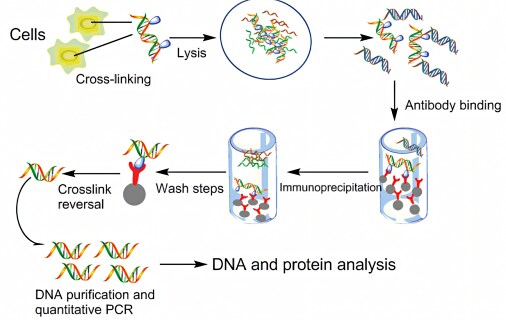Protein & Nucleic Acid Interactions

Proteins are the workhorse molecule inside of a cell and are responsible for the myriad of biological activities that cells undergo to function and survive. Interestingly, a diverse set of proteins also interact with DNA. DNA within our chromosomes is often tightly bundled around proteins that are referred to as the chromatid within the chromosome. These protein-DNA bundles help package the DNA into a compact form within the cell nucleus. Powerful molecular tools and techniques have been developed by researchers to isolate these protein-DNA bundles and other DNA-binding protein complexes for further downstream applications.
Immunoprecipitation
Immunoprecipitation using highly specific antibodies to RNA and DNA-binding proteins (e.g. transcription factors), scientists can evaluate the regulation of molecular pathways and better understand gene function in both healthy and disease tissues.
Numerous technologies and methods are currently available to investigate protein-RNA and protein-DNA interactions and are suitable for additional downstream analyses. For example, chromatin immunoprecipitation (ChIP) assays are often used to investigate transcription factor-DNA interactions for gene expression and epigenetic modification studies. Whereas, RNA precipitation (RIP) assays are commonly used to investigate proteins binding to mRNAs, non-coding RNAs, miRNAs, and viral RNAs. A common challenge with immunoprecipitation studies is the specificity and or access of the antibody to the protein of interest. To circumvent some of these issues, researchers will use recombinant protein technology to express modified proteins with unique tags, such as the hemagglutinin (HA) tag, that are recognized with high specificity by the appropriate antibody.
Visit our document search for data sheets, certificates and technical documentation.
Proximity Ligation Assay Technology
Interestingly, scientists leveraging protein-DNA technologies have devised novel tools and methods for evaluating protein-protein interactions. With high specificity and sensitivity, proximity ligation assay (PLA) technology facilitates in situ detection of endogenous proteins, protein modifications, and protein interactions. Similar to immunoprecipitation techniques, the PLA assay uses highly specific primary antibodies to recognize the two proteins of interest. However, modified oligonucleotide-labeled secondary antibodies, functioning as the PLA probe, are used to bind to the primary antibodies. Only if both proteins are present and nearby will the hybridizing connector oligos join the PLA probes. The addition of ligase forms a closed, circular DNA template. With the newly formed circular DNA template formed, rolling-circle amplification is now possible with the addition DNA polymerase and ultimately generates a greatly amplified signal that is tethered to the PLA probe. The selection of the appropriate protein and nucleic acid interaction technology will largely be determined by the researcher’s downstream application needs.
Related Articles
- Learn how Proximity Ligation Assay technology works and how the protein-protein interaction control kit can confirm in situ detection of EGF-induced EGFR-HER2 dimerization.
- Peptide synthesis up to 200 amino acids with HPLC purification, offering various purity levels, scales, and modifications.
- RNA Immunoprecipitation (RIP) is an essential method for analyzing proteins that interact with and modify the function of mRNAs, small RNAs, viral RNAs, or lncRNAs.
- Duolink® PLA Multicolor technology and the quantification of protein-protein interactions in fixed tissues and cells.
- Support information including tips and tricks, frequently asked questions, and basic troubleshooting.
- See All (25)
Related Protocols
- This protocol describes how to perform immunofluorescent detection of proteins in cells and tissue.
- Duolink® kits use in situ PLA® technology for accurate quantification of individual proteins, interactions, and modifications in cells and tissue.
- The video follows the simple and straightforward procedure that allows you to detect, quantify and obtain cell localization of protein interactions and their modifications in a single experiment.
- This page shows how to purify or remove DNA-binding proteins with Heparin Sepharose High Performance, Heparin Sepharose 6 Fast Flow, Capto Heparin from Cytiva.
- See All (15)
Find More Articles and Protocols
How Can We Help
In case of any questions, please submit a customer support request
or talk to our customer service team:
Email custserv@sial.com
or call +1 (800) 244-1173
Additional Support
- Chromatogram Search
Use the Chromatogram Search to identify unknown compounds in your sample.
- Calculators & Apps
Web Toolbox - science research tools and resources for analytical chemistry, life science, chemical synthesis and materials science.
- Customer Support Request
Customer support including help with orders, products, accounts, and website technical issues.
- FAQ
Explore our Frequently Asked Questions for answers to commonly asked questions about our products and services.
To continue reading please sign in or create an account.
Don't Have An Account?